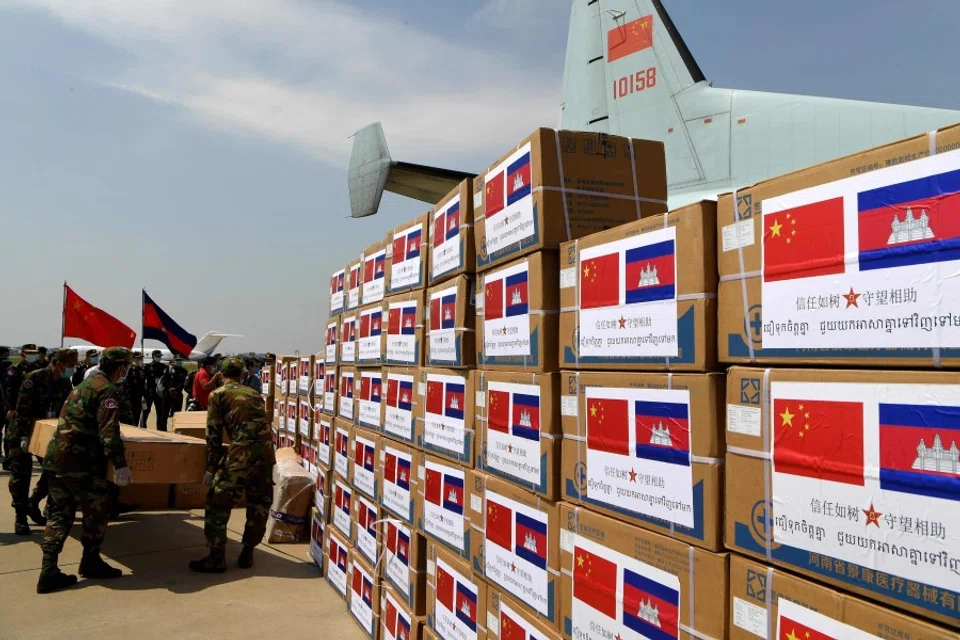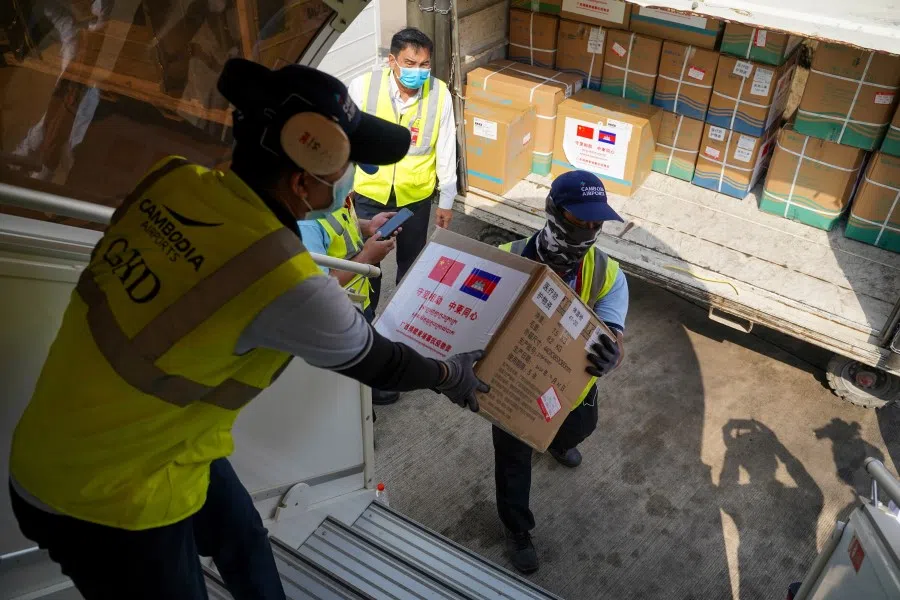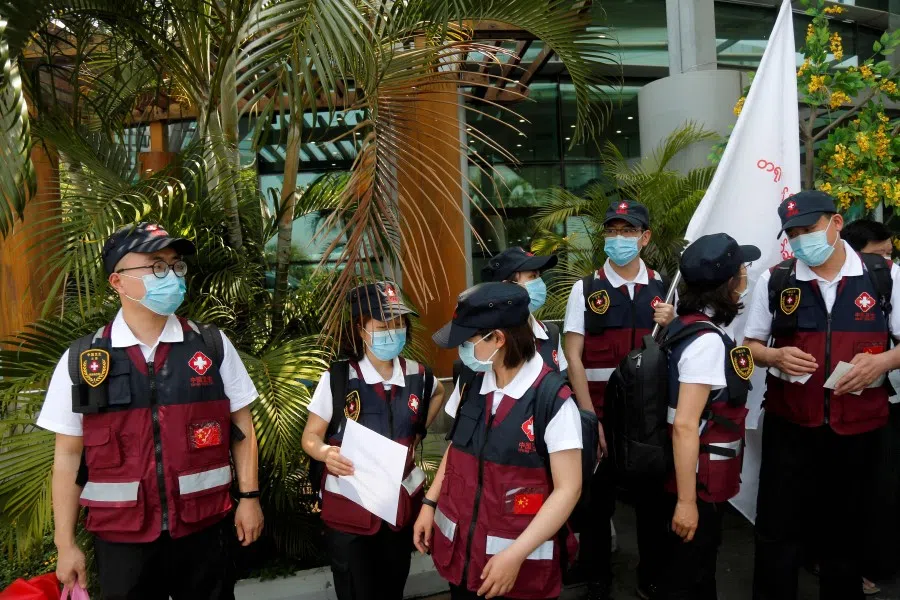China's aid to Southeast Asia amid adversity - a sign of deeper cooperation ahead?
Even as China continues to handle the coronavirus, it is extending aid to other countries, not least in Southeast Asia. ISEAS academic Lye Liang Fook traces China's efforts to engage ASEAN in building a "community with a shared future". Does that point to better relations between ASEAN member states and China?

Chinese President Xi Jinping has pledged China's commitment to helping the world fight Covid-19, not only in tackling the immediate health threat, but also in reviving the growth momentum of the world economy, and alleviating the burden on developing countries. One particular aspect of China's effort lies in its "mask diplomacy" where tonnes of medical supplies and equipment have been flown to various countries across the world.
The worldwide response to China's aid has been rather mixed. While many welcomed the assistance, others have questioned China's intentions with doubts similar to those raised over China's motivations behind the Belt and Road Initiative. In the same vein, Beijing has received brickbats over the quality of some China-made products.
Beijing's aid to the rest of the world, including Southeast Asia, picked up momentum since March 2020.
However, relatively little attention has been paid to China's assistance to Southeast Asia which, in contrast to other parts of the world, has proceeded in a relatively smooth and trouble-free manner. Beijing can be expected to do more in this area for ASEAN and the ASEAN Member States (AMS) at a time when its relations with other key countries are under increasing strain. Moreover, Southeast Asia is an integral part of Beijing's neighbourhood diplomacy to create a stable southern flank.
China's extension of aid
China started extending Covid-19 assistance to Southeast Asia in early February 2020, at a time when it was still in the thick of fighting the coronavirus threat within its own borders. However, Beijing's aid to the rest of the world, including Southeast Asia, picked up momentum since March 2020, especially after Chinese President Xi Jinping's much-anticipated visit to Wuhan on 10 March that marked a victory of sorts in China's fight against the coronavirus.
The Philippines, Cambodia and Myanmar were among the first in line. An obvious reason for this is probably due to the close ties between these countries and China.
The nature of China's assistance to Southeast Asia can be divided into two broad categories. The first category is material aid in the form of medical supplies and equipment. These include masks (such as face masks, surgical masks and KN95 respirators), test kits, thermometers, infusion pumps, ventilators and personal protective equipment (such as gloves, face shields, goggles, isolation gowns, protective suits and medical boot covers).
Material assistance
All AMS have received material assistance in some form from China although there is a difference in the order and scale of the assistance. The Philippines, Cambodia and Myanmar were among the first in line. An obvious reason for this is probably due to the close ties between these countries and China (most obviously so in the case of the Philippines and Cambodia). As for Myanmar, apart from its strategic importance (in offering China access to the Indian Ocean, thereby reducing its reliance on the Straits of Malacca), it also shares a common border with China. In addition, China has stood by Myanmar especially over the Rohingya issue where Naypyidaw is largely on the defensive in the face of criticisms from the rest of the international community.
The other ASEAN countries that feature relatively prominently in terms of the order and scale of China's material aid are Laos, Thailand, Malaysia and Indonesia. Even Brunei, which has had only 141 Covid cases (as of end May 2020), has been an active recipient of China's official and private sector assistance. Apart from the usual broad government-to-government and business-to-government channels, China has adopted a more targeted approach involving key institutions of both countries. For instance, the Chinese ambassador to Brunei, Madam Yu Hong, handed over an unspecified quantity of medical supplies and equipment from China's Ministry of National Defence to Brunei's Ministry of Defence on 14 May 2020.
However, there was virtually no mention of this donation by Vietnam's official media although it was widely reported by China's state media.

In comparison to the above countries, Vietnam and Singapore received limited material assistance and only in the later stages, sometime from April onwards. To a large extent, this may be due to these two countries being in a better position to handle the pandemic outbreak on their own. For Singapore, it was reported that China Communications and Construction Company, a state-owned company, helped to convert an existing facility belonging to the Civil Aviation Authority of Singapore into an isolation ward at short notice in April 2020. Singapore further received 600,000 masks from China in May 2020.
As for Vietnam, China's Ministry of Public Security donated a batch of medical supplies and equipment including masks, goggles, gloves and protective suits to its Vietnamese counterpart in May 2020. The aid was delivered at a border crossing between the two countries. However, there was virtually no mention of this donation by Vietnam's official media although it was widely reported by China's state media.
Interestingly, the medical team that arrived in Phnom Penh came ahead of a Chinese medical team sent on 28 March to Pakistan, which China traditionally regards as having an "ironclad" and "all-weather" friendship.
Other forms of assistance
The second category of China's assistance has to do with the softer aspects of sharing its experience and expertise in fighting the pandemic in areas such as prevention and control, testing, diagnosis, treatment and even training of their medical counterparts in Southeast Asia. There are also reports of China sharing its experience in combining Traditional Chinese Medicine with Western medicine in the treatment of COVID patients.
Most notably, China has sent civilian medical teams to five AMS. Cambodia was the first to receive a seven-member team from Guangxi Autonomous Region, on 23 March. In addition to stressing that the aid was to reciprocate Cambodia's earlier extension of assistance, China said that the aid demonstrated the "iron-clad" friendship between the two countries and the importance of building a "community with a shared future". Interestingly, the medical team that arrived in Phnom Penh came ahead of a Chinese medical team sent on 28 March to Pakistan, which China traditionally regards as having an "ironclad" and "all-weather" friendship.
The other ASEAN countries that received civilian medical teams were Laos (29 March), the Philippines (5 April), Myanmar (8 April) and Malaysia (18 April). The size of these teams ranged from seven to 12 members and the duration of their stay was usually two weeks. The personnel dispatched came from provincial medical institutions such as Guangxi (for Cambodia), Yunnan (for Laos, and Myanmar), Fujian (for the Philippines) and Guangdong (for Malaysia). The geographical distribution of these Chinese institutions highlights the country's access to a wider pool of resources at the local level which helped reduce the strain on Beijing's resources, which are meant for national emergencies and for its leaders.
Laos and Myanmar, like Cambodia, have committed to work with China to build a "community with a shared future".
There is a further difference in the type of medical teams sent. Among the five ASEAN countries mentioned above, two stand out for having received additional military medical teams from China. On 24 April, Myanmar and Laos received a six-man and five-man military medical team respectively from the Chinese People's Liberation Army. Each team also brought with them an unspecified amount of military supplies and equipment for their military counterparts in Yangon and Vientiane.
Military medical teams rank a rung higher than civilian medical teams and are considered better trained and have a higher political signature. They underscore the added importance China attaches to these two mainland Southeast Asian countries with which it shares a common border. In addition, Laos and Myanmar, like Cambodia, have committed to work with China to build a "community with a shared future".

At the regional level, China and ASEAN have promoted the sharing of experience and expertise as well through video conferencing sessions. So far, two such sessions have been held. On 20 February 2020, health officials and clinical experts from ASEAN and China met to exchange practices and challenges in the clinical management of Covid-19 cases and to mitigate its impact on communities. On 31 March 2020, they met a second time to discuss further cooperation in areas such as enhancing capacity building interventions; sharing of technical information and updates, lessons learnt and good practices; strengthening cooperation in risk communication and assessment; and strengthening policy dialogue on the pandemic including drug and vaccine development, security and self-reliance.
Its aid provision is occurring at a time when Beijing's relations with other key players has become increasingly strained.
These softer aspects of cooperation come on top of other more formal and senior cooperation mechanisms involving ministers and heads of government such as the Special ASEAN-China Foreign Ministers' Meeting (on 20 February 2020) and the Special ASEAN Plus Three (APT) Summit on Coronavirus Disease (on 14 April 2020). At the latter meeting, the countries agreed, among other things, to explore setting up an APT reserve of essential medical supplies to enable rapid response to emergency needs. They further committed to keep markets open for trade and investment, and strengthen the resiliency and sustainability of regional supply chains, especially for essential goods such as food, commodities, medicines and medical supplies.
ASEAN and AMS receptive to China's Covid-19 aid
Some key observations can be drawn from China's Covid-19 assistance to Southeast Asia especially in terms of the context. Its aid provision is occurring at a time when Beijing's relations with other key players has become increasingly strained. Most prominently, the war of words between China and the US on the pandemic has intensified. America has accused China of cover-ups and a delayed response to the pandemic while China contends that America is resorting to a blame game to divert attention from its own poor response to the pandemic. The two have now locked horns over the national security law on Hong Kong. The heightened tensions between the two countries are expected to endure in the run-up to the US presidential elections in November 2020.
China's relations with the EU and some European countries have also run into difficulties. Incidents like the EU toning down part of a report about Chinese state-backed disinformation, and China Daily, a state-run newspaper, censoring an article co-written by the EU 27 ambassadors by removing references linking the outbreak of the coronavirus to China, have dampened relations. Some European countries have issues with the quality of China-made masks and test kits. China also appears to have grudgingly accepted the World Health Assembly's (WHA) call for an "impartial, independent and comprehensive evaluation" of the global response to the pandemic based on an earlier EU draft, when it was initially opposed to any such probe.
In general, ASEAN and AMS have been receptive of China's provision of Covid-19 aid. Most of them do require such assistance.
China-Australia ties have hit a new low with Canberra's strong push for an independent international review into the origins and spread of the pandemic. From early suggestions of a boycott of Australian products by Chinese consumers, Beijing has imposed tariffs of 80.5% on Australian barley (due to alleged dumping) and banned imports of beef from four Australian exporters (due to alleged inspection and quarantine breaches). It has dismissed Australia's claim that its push for a review was vindicated by the WHA's call for a probe by calling it a "joke" and insisting that the two proposals were "totally different".
Closer to home, there is also increased caution in the development of China-Japan relations with the Japanese government announcing the setting aside of a sum of US$2.2 billion to encourage its businesses to shift manufacturing of high value-added products back to Japan, and for the production of other goods to be spread across Southeast Asia. South Korean companies are also reportedly considering moving some of their factories from China to India. China-India ties are once again dogged by border tensions which last flared up in 2017.
A related point is an absence of "wolf warrior" diplomacy involving Chinese officials in the region as had happened in France, Australia and Sri Lanka.
Comparatively, China's relations with ASEAN as a whole and with AMS individually have been relatively stable minus the South China Sea issue. In general, ASEAN and AMS have been receptive of China's provision of Covid-19 aid. Most of them do require such assistance. There have also not been any public reports from ASEAN or AMS regarding the quality of China's pandemic assistance. A related point is an absence of "wolf warrior" diplomacy involving Chinese officials in the region as had happened in France, Australia and Sri Lanka. This has largely been due to the lack of issues warranting such a practice.

China's provision of Covid-19 assistance to ASEAN and AMS cannot be divorced from the wider context of China's deteriorating relationship with other major partners.
Even before the onset of Covid-19, China had made a conscious effort to keep its relations with ASEAN and AMS on a generally positive note. This was especially true after US-China relations deteriorated in 2018 with tariffs and counter-tariffs being imposed. In a rather unusual gesture, Chinese Premier Li Keqiang committed China to a three-year deadline to conclude consultations on a Code of Conduct in the South China Sea with ASEAN when he visited Singapore in November 2018. China and ASEAN further embarked on their first maritime drill in Zhanjiang (Guangdong) in October 2018 and several AMS' navies took part in the 70th anniversary celebration of the founding of the PLA Navy, in April 2019 in Qingdao (Shandong).
China's provision of Covid-19 assistance to ASEAN and AMS cannot be divorced from the wider context of China's deteriorating relationship with other major partners. Arising from this, Beijing seeks to keep its Southeast Asia front manageable and relatively trouble-free. Another important reason is that China and six AMS cross important milestones in 2020 such as the 70th anniversary of relations with Indonesia, Vietnam, and Myanmar; the 45th anniversary of relations with Thailand and the Philippines; and, the 30th anniversary of relations with Singapore. Hence, Beijing has placed greater emphasis on developing ties with Southeast Asia. The tone was set when Chinese President Xi Jinping chose Myanmar to be the first foreign country to visit at the beginning of this year.
Other oft-cited reasons behind China's Covid-19 assistance include China's objective of demonstrating that it is a responsible player on the global stage; reciprocating the assistance it had earlier received from Southeast Asia; and seeking to build a "community with a shared future" by tackling common challenges together. All of these objectives are geared towards promoting China's interests, including the shaping of a positive image of itself in the region.
Bright spots in ASEAN countries' relations with China ahead?
China's Covid-19 assistance to ASEAN and AMS has been an overall positive spark in China's relations with Southeast Asia. Going forward, Beijing can be expected to continue to render aid to these countries not only to bring the pandemic under control but also to work with them to recover from the socio-economic impact of the pandemic. For one thing, they have reiterated their commitment to keeping markets open for trade and investment so as to uphold the multilateral trading order and globalisation which are key to economic recovery. They have also started exploring "people-to-people" travel on a selective basis. China and Singapore have established a "fast lane" arrangement in early June 2020 to facilitate essential travel for business and official purposes between the two countries. More such arrangements are likely to be set up between China and Southeast Asia.
Moreover, while racing to develop a vaccine, Chinese President Xi Jinping has vowed to make the vaccine a "global public good" that is readily accessible and affordable especially to developing countries once it is developed and deployed in China. It will be interesting to watch how this pans out.
From the perspective of the AMS, they welcome an engagement with China that brings mutual benefits and that does not preclude them from growing their ties with other key players such as Japan, Australia, the EU and the US. Being much smaller, the AMS are acutely aware of how bigger powers can come to wield a disproportionate amount of influence over them.
With respect to China, past incidents serve as a reminder of this including the Philippine-China standoff over the Scarborough Shoal (in 2012), the Vietnam- China standoff over the Chinese Oil Rig 981 deployment near the Paracel Islands (in 2014), the nadir in Philippine-China relations arising from the arbitral tribunal case brought by the Philippines against China (from 2013 - 2016), and the downward spiral in Singapore-China relations over issues related to the South China Sea and their relationship with the US (in 2016).
This article was first published as ISEAS Perspective 2020/58 "China's COVID-19 Assistance to Southeast Asia: Uninterrupted Aid amid Global Uncertainties" by Lye Liang Fook.



![[Big read] Love is hard to find for millions of rural Chinese men](https://cassette.sphdigital.com.sg/image/thinkchina/16fb62fbcf055b710e38d7679f82264ad682ce8b45542008afeb14d369a94399)
![[Big read] China’s 10 trillion RMB debt clean-up falls short](https://cassette.sphdigital.com.sg/image/thinkchina/d08cfc72b13782693c25f2fcbf886fa7673723efca260881e7086211b082e66c)
